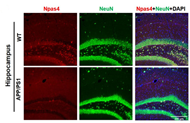Brain regions differences in amyloid-β and gene expression in early APP/PS1 mice and identification of Npas4 as a key molecule in Alzheimer's disease
DOI:
https://doi.org/10.17305/bb.2024.10820Keywords:
Alzheimer’s disease, amyloid-β, cerebellum, cortex, hippocampus, Npas4Abstract
Distinct brain regions are differentially affected during the various stages of Alzheimer's disease (AD). While the hippocampus and cortex are known to play significant roles, the involvement of the cerebellum has received less attention. Understanding the changes in diverse brain regions is essential to unravel the neuropathological mechanism in early-stage AD. Our research aimed to explore and compare amyloid-β (Aβ) pathology and gene expression profiles across the hippocampus, cortex, and cerebellum in the early stages of the Amyloid Precursor Protein/Presenilin-1 (APP/PS1) mouse model. By 7 months of age, significant Aβ plaque accumulation was observed in the hippocampus and cortex of APP/PS1 mice, while no such deposits were found in the cerebellum. Gene expression analysis revealed predominant effects on immune response pathways in the hippocampus and cortex. Even in the absence of Aβ deposition, notable gene expression changes were observed in the cerebellum of APP/PS1 mice. Intriguingly, Neuronal PAS Domain protein 4 (Npas4) expression was consistently down-regulated across all brain regions, independent of Aβ plaque presence. Our findings reveal distinct transcriptomic alterations and Aβ pathology in select cerebral regions during the initial phase of AD. Notably, the diminished expression of the Npas4 across three brain regions implies that Npas4 could play a pivotal role in the early pathogenesis of AD.
Citations
Downloads

Downloads
Published
Data Availability Statement
The data supporting the findings of this study are available on request from the corresponding author. RNAseq raw data will be accessible in a data bank after paper publication.
Issue
Section
Categories
License
Copyright (c) 2024 Niya Wang, Zhong Zhao, Xiaoyan Wang, Xinzhang Chen, Fengwen Jiang, Yahong Tan, Wenli Chen, Qiang Meng

This work is licensed under a Creative Commons Attribution 4.0 International License.









